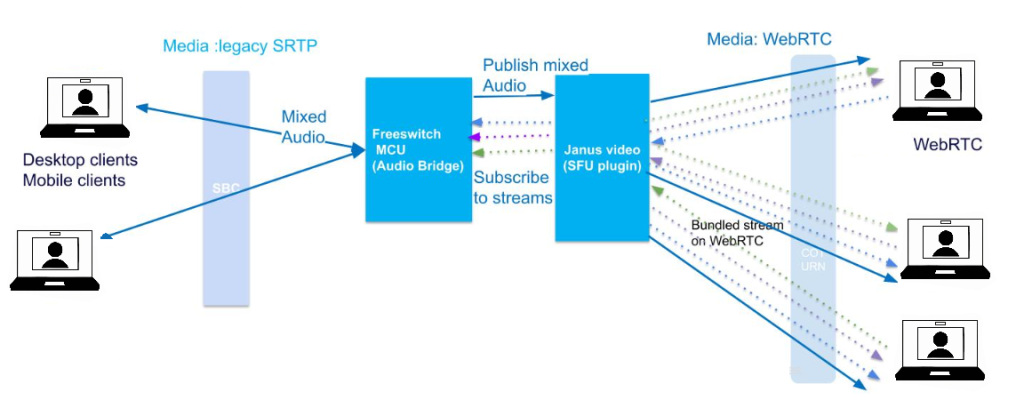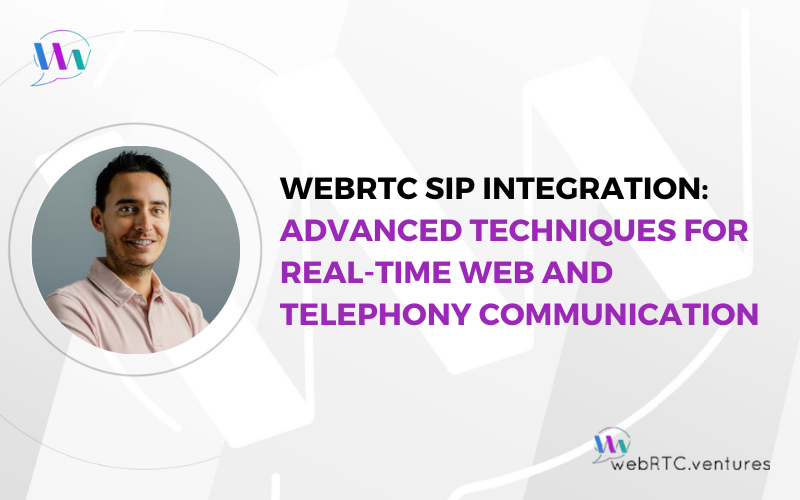Bringing WebRTC and SIP together is a powerful way to connect modern web applications with traditional phone systems. Whether you’re enabling voice and video in the browser, or linking your app to a PBX and SIP trunk, WebRTC SIP integration allows users to communicate across platforms without needing special hardware or downloads.
While the goal is clear, the integration process can be complex. WebRTC and SIP use different signaling protocols, media formats, and security models. Making them work together reliably requires thoughtful architecture, codec handling, and compatibility planning.
In this guide, we’ll explore three practical integration strategies for real-time web and telephony communication, highlight common challenges, and share best practices based on production systems our team at WebRTC.ventures have built and deployed.
Why Integrate WebRTC and SIP?
Combining WebRTC and SIP makes sense. SIP links your web app with classic phone systems and telephony networks. WebRTC brings web-friendly, peer-to-peer communication into the mix. By blending them, you can build apps that work inside browsers and also connect seamlessly to traditional phone lines, offering users a unified experience.
Common WebRTC SIP Integration Challenges and Solutions
Before exploring the integration challenges between WebRTC and SIP, it’s crucial to understand their underlying differences in how they handle media transport, session negotiation, NAT traversal, security, and codecs.
The following table summarizes the most relevant distinctions:
Protocol and Codec Compatibility Issues and Media Transcoding
WebRTC enforces RTP with secure encryption (SRTP), while SIP often uses plain RTP without encryption by default. Common codecs can create compatibility challenges—G.711 (typical in SIP phones) and Opus (commonly used in WebRTC) can’t communicate directly.
To bridge these differences, media transcoding is often needed—changing codecs or formats so incompatible devices can understand each other. For example, bridging a SIP device using G.711 with a WebRTC endpoint using Opus might require converting media streams. Hardware like Cisco Z70 video phones may also need special commands to work correctly with WebRTC. Even when using the same video codec, for example, H264, synchronizing when each device creates keyframes (the frames that start the video) can also cause issues.
Signaling and Session Negotiation Differences
In WebRTC, session details are exchanged using SDP (Session Description Protocol). SIP also uses SDP, but how they handle it can vary. WebRTC uses ICE protocols like Trickle ICE plus STUN and TURN servers to traverse firewalls. In contrast, while SIP can use ICE, support is often incomplete or varies between implementations. These differences make connecting the two systems more complicated.
WebRTC SIP Integration: Architectural Approaches
Below are three proven patterns, each with trade-offs:
Direct SIP Use with WebRTC (Approach A)
Web and mobile apps connect directly via SIP, through gateways and proxies. Media flows straight into SIP servers, which handle calls to traditional phones.
Benefits of Direct SIP Integration with WebRTC Architecture
- Good if your system already uses SIP
- Supports legacy features
Limitations of Direct SIP Integration with WebRTC Architecture
- Larger server load because of media mixing (MCU)
- Fixed layouts for video calls
- Steep learning curve if you’re new to SIP
Signaling Over WebSockets with SIP (Approach B)
WebRTC clients send signaling data via WebSockets to your server, which then handles SIP signaling. This decouples media from signaling.
Benefits of WebSocket Signaling with SIP Backend Architecture
- Easier client development
- Flexible choice of signaling protocols
Limitations with WebSocket Signaling with SIP Backend Architecture
- Higher CPU use on the server
- Limiting layouts
- Latency issues if not optimized properly
Media Servers with SIP Gateways (Approach C)
Media servers (like SFU or MCU) handle media streams, while a SIP gateway connects to the telephony network.

Popular open source frameworks used when implementing a Media Servers with SIP Gateways architectural approach include: Asterisk, FreeSwitch, FreeSwitch, LiveKit, MediaSoup, OpenVidu (previously Kurento), Janus and Jitsi.
Benefits of Media Server with SIP Gateway Architecture
- More flexible and scalable
- Supports advanced WebRTC features like simulcast and video quality adaptation
- Cost-efficient for large calls
Limitations of Media Server with SIP Gateway Architecture
- More complex architecture to manage
- Requires good media management
- Monitoring and troubleshooting get trickier
Best Practices for WebRTC SIP Integration
The following best practices address the most common pain points uncovered in SIP WebRTC integrations, with a focus on optimizing infrastructure, signaling, media interoperability, and observability.
By proactively planning around these practical considerations, you can deliver a seamless and resilient communication experience across both SIP and WebRTC endpoints.
Best Practices for WebRTC SIP Infrastructure Planning and Scalability
- Budget for CPU-intensive transcoding workloads
- Consider deploying STUN/TURN close to users
- Monitor network paths to SIP trunks. Monitor not just signaling latency but also RTP path characteristics (packet loss, jitter). SIP providers differ greatly in media performance.
Best Practices for WebRTC SIP Signaling Robustness and Error Handling
- Use WebSockets with automatic reconnection
- Detect network path changes (e.g., mobile client switching Wi-Fi to LTE) and trigger ICE restarts
- Validate all SDP flows, including corner cases (e.g., re-INVITE, UPDATE)
- Media Control Harmonization: Implement SIP INFO or re-INVITE for hold/mute, and map RTCRtpSender.track.enabled consistently to SIP signaling. Ensure that, for example, mute state changes in telephony propagate back to WebRTC clients to avoid user confusion.
Best Practices for WebRTC SIP Codec Strategy and Media Optimization
- Pre-negotiate codec priorities (Opus ↔ G.711, VP8 ↔ H.264 baseline)
- When possible, prefer end-to-end Opus for best voice quality
- Fall back to transcoding as a last resort
- DTMF Handling: Many SIP trunks expect RFC 2833 RTP DTMF events, while WebRTC transmits DTMF via RTP events. Ensure your gateway correctly bridges these signals.
Best Practices for WebRTC SIP Observability and QA
- Instrument call flows end-to-end
- Correlate signaling logs and RTP stats. Open source tools like Homer are a great option.
- Continuously test call scenarios (browser-to-phone, phone-to-browser, multi-party)
- Simulate adverse conditions (high jitter, packet loss) to validate system resilience
Future of WebRTC SIP Integration
As real-time communication platforms continue to evolve, the integration between WebRTC and SIP must also adapt to support emerging user expectations and technologies. Looking ahead, several trends are shaping the future of this integration—from multi-modal communication workflows to AI-driven enhancements and immersive collaboration environments. These advancements will not only expand what’s possible but also introduce new interoperability challenges that developers and architects must be ready to address.
- Multi-Modal or Multi-Channel Communications: Users expect frictionless transitions among chat, voice, and video. Standardized APIs and CPaaS platforms have accelerated this convergence.
- AI-Driven Enrichment and Automation: Real-time transcription, language translation, and even intelligent routing are becoming baseline expectations.
- Immersive Collaboration: Virtual environments and avatars will push beyond simple video tiles, creating new interop challenges for SIP and WebRTC.
As AI, multi-channel workflows, and immersive experiences become standard, we must build modular, adaptable systems that are ready to evolve.
Planning Your WebRTC SIP Integration
As demonstrated throughout this guide, integrating WebRTC and SIP is a complex process that requires deep technical expertise, careful architectural planning, and thorough testing across varied network conditions. Successfully navigating these challenges is essential to delivering a reliable and seamless communication experience.
Navigating the complexities of WebRTC-SIP integration can be challenging. Our experts at WebRTC.ventures are here to help you turn your vision into a robust, production-ready solution. We offer a full range of services tailored to meet your needs:
- Architecture Design & Consultation: Custom solution blueprints for your specific requirements
- Full-Stack Implementation: End-to-end development with modern frameworks and protocols
- Performance Optimization: Codec tuning, latency reduction, and scalability improvements
- Testing & Quality Assurance: Comprehensive testing across devices, networks, and edge cases
- Migration & Integration: Seamless integration with existing telephony infrastructure
- Ongoing Maintenance: Continuous monitoring, updates, and performance optimization
Contact WebRTC.ventures today.
Further Reading:














